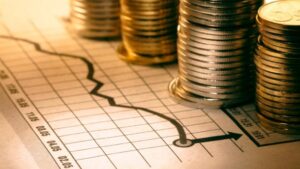
In a new episode of the Experts Club YouTube channel, Maksim Urakin, PhD in Economics, presented an analysis of macroeconomic trends in Ukraine and the world based on official data from the State Statistics Service of Ukraine, the NBU, the UN, the IMF, and the World Bank.
Macroeconomic Indicators of Ukraine
Maksim Urakin cited data from Ella Libanova, Director of the Institute for Demography and Social Studies, who estimates that about 50% of citizens will return after the war.
“Demographics is an important factor for economic recovery, but the threat of depopulation and labor shortages cannot be ignored. In the medium term, the decline in the demographic growth potential in Ukraine can only be offset by migration,” Urakin emphasized.
The expert noted that the main risks to the economy remain the duration of the war and the instability of international aid.
“In the third quarter of 2023, Ukraine’s GDP growth slowed to 8.2%. The negative balance of foreign trade increased 3.2 times, which is an alarming signal. The public debt has slightly decreased compared to August figures, but in 2024 it may exceed the country’s GDP for the first time, which poses significant risks to economic stability,” the economist said.
Prospects for the Global Economy
The founder of Experts Club also analyzed the global economy, noting a slowdown in growth in 2024 to 2.2%.
“One of the key reasons for the slowdown in global economic growth is the decline in GDP in developed countries. We are witnessing the lowest GDP growth in developed countries since the 1980s, with the exception of the global financial crisis and the COVID-19 pandemic. The unprecedented cycle of interest rate hikes by major central banks in recent years has also played a significant role in slowing growth. These rate hikes are driven by the need to control inflation, but at the same time, they limit economic activity,” the expert explains.
According to the expert, the current macroeconomic situation in Ukraine and the world requires further analysis. For Ukraine, the main challenges in the coming years will be the need to restore Ukraine after the war and manage the public debt.
For more information on the situation in the Ukrainian and global economy, please see the video on the YouTube channel “Club of Experts” at the link: https://www.youtube.com/watch?v=byJnfmie7bM
You can subscribe to the channel here: https://www.youtube.com/@ExpertsClub
ECONOMY, economy review, EXPERTS CLUB, MACROECONOMICS, URAKIN, world economy

The volume of Ukraine’s gross external debt increased by $8.8bn during the second quarter of this year and amounted to $148.6bn at the end of the half-year, according to the website of the National Bank of Ukraine (NBU).
“Relative to GDP, the debt increased from 90.5% to 92.7%,” the National Bank noted.
At the same time, the external debt of the public sector for the second quarter of 2023 increased by $8.4 billion to – $84.5 billion (52.7% of GDP), while the debt of the private sector – by $0.4 billion to $64.1 billion (40% of GDP).
As indicated by the National Bank, the growth in the public sector was due to net attraction of $8.8 billion in loans from international partners, including $3.6 billion from the International Monetary Fund (IMF), while the government debt on securities decreased by $0.12 billion.
According to the central bank, the volume of external liabilities of Ukrainian banks decreased by $0.08bn to $1.8bn (1.1% of GDP), mainly due to the reduction of debt on loans by a similar amount.
External debt of other sectors of the economy increased by $0.2bn to $41.3bn (25.8% of GDP). As explained by the regulator, this was due to the growth of external debt on guaranteed loans – by $0.14 billion and securities – by $0.05 billion.
Debt of other sectors of the economy, including intercompany debt, increased by $0.52 billion to $62.3 billion (38.9% of GDP) in the reporting quarter.
Direct intercompany debt of enterprises in direct investment relations increased by $0.28 billion to $21 billion (13.1% of GDP) in the quarter due to the increase in external debt on credits and loans of direct investors by $0.26 billion.
The NBU estimated the increase in private sector debt due to exchange rate changes at $0.4 bln.
The volume of overdue debt of the real sector on non-guaranteed loans (including from direct investors) increased by $0.13bn in April-June and amounted to $25.4bn (15.9% of GDP) at the end of the second quarter. According to the NBU, the share of Cyprus in it is 58.1%. In addition, the shares of the UK increased by 1 percentage point (p.p.), to 9.2%, and the Netherlands – by 3 p.p., to 5.8%.
According to the National Bank, Cyprus at the end of the second quarter remained the main creditor country in terms of the geographical structure of private sector debt on non-guaranteed loans (together with intercompany debt) – 49.2% of the total volume, its share since the beginning of the year increased by 0.4 p.p.
The shares of the Netherlands, Germany and Switzerland increased by 0.1 pp. to 7.3%, 3.0% and 2.6% respectively, while the share of the USA remained at 3.0% and the shares of the UK and Luxembourg decreased by 0.1 pp. – to 10.7%.
The main currency of Ukraine’s external borrowings at the end of Q2 2023 remains the US dollar – 50% of total external debt, but its share decreased by 3 p.p. over the quarter. At the same time, the share of borrowings in euros increased from 31.9% to 33.8%, as well as in SDRs to the IMF – from 9.9% to 11.4%, while the share of external debt in hryvnia decreased by 0.2 p.p. to 1.6%. – to 1.6%.
The volume of short-term external debt by residual maturity for the second quarter of 2023 increased by $1.2 billion and amounted to $40.8 billion as of June 30, 2023.
Meanwhile, general government liabilities that require repayment over the next 12 months increased by $0.9 billion to $3.8 billion due to higher future government loan repayments, including $0.2 billion to the IMF, while central bank repayments decreased by $0.18 billion to $1.3 billion due to lower IMF repayments.
The volume of short-term liabilities of the banking sector remained almost at the level of the previous quarter and amounted to $1.3 bln.
The total volume of real sector borrowings (together with intercompany debt), which are to be repaid over the next 12 months, increased by $0.5bn and amounted to $34.4bn as of June 30, 2023. The National Bank specified that the growth is due to an increase in the volume of future repayments on debt securities by $0.4bn.
Experts Club research project and Maxim Urakin recently released an analytical video about the economy of Ukraine and the world.
Subscribe to the Experts Club YouTube channel by clicking here – https://www.youtube.com/@ExpertsClub

The YouTube channel “Experts Club” has published a new video in which the founder of this think tank, Maksym Urakin, provides his analysis of Ukraine’s macroeconomic indicators and the state of the global economy in the first half of 2023.
Demographic indicators of Ukraine
Speaking about the demographic factor in the development of the Ukrainian economy, the expert cited data from the Opendatabot portal, which shows that the birth rate in the country continues to decline. According to these data, about 97 thousand children were born in the first half of 2023, which is 28% less than in the same period of 2021.
“The birth rate has been declining by about 7% annually since 2013. However, the full-scale war has aggravated the situation, causing the largest crisis in natural population growth. The demography of our country continues to be under pressure due to the current circumstances,” said Maksym Urakin.
According to him, in the first half of 2023, the number of marriages fell by 17% compared to the same period last year, while the number of divorces increased by a third, especially in Kyiv.
Economic recovery
Turning to the macroeconomic sphere, the economist emphasized that the Ukrainian economy has started to show signs of recovery.
“According to the NBU, Ukraine’s economy grew by 18.3% in the second quarter relative to the same period last year. This growth is relative to the period of the greatest decline at the beginning of the war.”, – said the founder of the club of experts.
Nevertheless, Maxim Urakin expressed concerns about the long-term outlook.
“Despite the current positive trend, the main risk for the Ukrainian economy continues to be related to the duration and intensity of the war. This may complicate the recovery, as well as cause problems with inflation and currency exchange rate,” Urakin noted.
According to him, the main negative factors affecting economic activity are a decrease or instability of international aid, as well as possible further destruction of energy infrastructure and problems with electricity supply in the fall and winter period.
Analysis of Ukraine’s foreign trade
Maxim Urakin also drew attention to the factor of growth of the negative balance of foreign trade, which has been noted since the beginning of the war.
“The country’s negative foreign trade balance continues to grow, reaching $9 billion in the first five months of this year, according to Gosstat estimates. This suggests that Ukraine is spending more currency on importing goods than it earns from exporting them. We see a sharp drop in exports of mineral products by 39.3%, ferrous and non-ferrous metals by 21.4%, wood and wood products by 17.7%, machinery products by 18.2%, chemical industry by 21.4% and other industrial goods by 4.1%,” – said the candidate of economic sciences.
However, not all the news in this sphere was pessimistic. Urakin emphasized the growth of food exports by 9.9%, which indicates the potential of the Ukrainian agro-industrial complex, which will probably become one of the main drivers of the country’s economic recovery in the coming years.
As for the balance of foreign trade in services, although still negative, the pace of its reduction gave some grounds for optimism.
“We see that the deficit of foreign trade in services is shrinking, which may indicate a gradual recovery of some service sectors in Ukraine,” the expert concluded.
Ukraine’s financial situation in 2023
However, equally important aspects of the economy, according to the expert, are government debt, international reserves and inflation.
“The country’s public debt continues to increase its volume. By the middle of 2023 he Ukraine approached the mark of 140 billion dollars. At the same time, the International Monetary Fund (IMF) has adjusted its forecasts on the level of the country’s public debt, reducing it from 98.3% of GDP to 88.1% of GDP. Despite this ‘positive’ realistic revision, this level of debt represents a significant burden for the national economy,” Maxim Urakin said.
The main source of financing of Ukraine’s budget, according to the expert, is still related to foreign aid.
“Half of the budget is financed by taxes and fees, while the rest comes from international grants and loans,” he emphasized.
Nevertheless, the country’s international reserves have shown positive dynamics.
“By August this year, Ukraine’s international reserves reached a record $41.72bn, which is 6.9% higher than the previous record. This increase is probably the result of active external financial support,” the analyst said.
As for inflation, it showed a slowdown. “After a record 27% inflation in 2022, this indicator fell to close to 4% in July this year,” Urakin noted.
Thus, the economic situation in Ukraine, according to the founder of the “Experts Club”, continues to be complex and multifaceted, requiring careful monitoring and adaptation of strategies in response to changing conditions.
World economy in 2023: analysis and forecasts
In the last presented studies of the “Experts Club” the economic situation in Ukraine was actively considered, however, according to Maxim Urakin, the dynamics of the world economy also has a significant impact on our country. According to the latest data, the world economy shows stable signs of growth, but there are also certain risks.
“The IMF has recently provided its forecasts for global economic growth. A growth of 3% is forecast for 2023 and the same is expected in 2024. The decisions taken by the US to resolve issues related to the level of public debt, as well as active actions in the US and Swiss banking sectors, have helped to reduce the immediate risks of a crisis in the global financial market. However, as the IMF emphasized, “the balance of risks remains tilted towards a possible deterioration of the economic situation at the global level,” the economist explained.
Inflation continues to be in the center of experts’ attention. Although the IMF lowered its inflation forecast for the current year to 6.8%, expectations for 2024 were adjusted upward.
Based on this information, Maxim Urakin concludes that the global economy is on the way to stabilization, but the situation remains ambiguous due to a number of uncertain factors. It is important for countries and their economies interacting in the global market to monitor changes and prepare for possible challenges.
Economic development in individual countries
According to the founder of the “Experts Club”, the global economy in 2023 is showing mixed results. While some countries are overcoming the effects of the pandemic and are on the path to stable growth, others are facing challenges from internal and external factors.
“The U.S. economy exceeded expectations, posting above-forecast growth. Meanwhile, consumer spending and government spending also showed solid growth, but residential investment continues to decline. China, which is on the road to recovery from the pandemic, showed strong economic growth, although the construction industry continues to experience a crisis. The Eurozone has shown moderate growth, with the region’s largest economy, Germany, facing recession. At the same time, the UK and Japan have positive adjustments to their GDP forecasts. India continues to strengthen its economic position, showing dynamic growth. Meanwhile, Brazil, although showing growth in the current year, expects a decline by 2024,” summarized the expert.
For more details on the situation in the Ukrainian and global economy, see the video on the YouTube channel “Club of Experts” at the link:
You can subscribe to the channel here:
ECONOMICS, EXPERTS CLUB, MACROECONOMICS, REVIEW_OF_ECONOMICS, URAKIN, WORLD_ECONOMY

The article summarizes and analyzes the main macroeconomic indicators of Ukraine. In connection with the entry into force of the Law of Ukraine “On Protection of the Interests of Business Entities during Martial Law or a State of War”, the State Statistics Service of Ukraine suspends the publication of statistical information for the period of martial law, as well as for three months after its termination. The exception is the publication of information on the consumer price index, separate information on statistical indicators for 2021 and for the period January-February 2022. The article analyzes open data from the State Statistics Service, the National Bank, and think tanks.
In the first quarter of 2023, Ukraine’s real GDP fell by 10.5% compared to the first quarter of 2022, after falling by 31.4% in the fourth quarter, 30.6% in the third quarter, 36.9% in the second quarter, and 14.9% in the first quarter of last year.
Overall, analysts expect modest GDP growth in Ukraine in 2023. Thus, the World Bank slightly downgraded its forecast for Ukraine’s gross domestic product growth in 2023 to 2% from 3.3%, which it predicted in January 2023. Raiffeisen Bank maintained its forecast of 1.8% growth in Ukraine’s gross domestic product for 2023.
Maksym Urakin, founder of the Kyiv-based think tank Club of Experts, drew attention to key macroeconomic indicators. “Ukraine’s macroeconomic indicators have stabilized, and international reserves due to borrowings are breaking records, but Ukraine’s negative foreign trade balance is having a negative impact on the economy,” said Maksim Urakin.
Inflation in Ukraine will decline to 15.5% in 2023, and real incomes will increase by 1%, according to the updated improved forecast released by the International Monetary Fund (IMF) following the first review of the EFF Extended Fund Facility program.
Ukraine’s total public debt grew by 3.6% and reached a new historical high: in dollar terms, by $4.37 billion to $124.28 billion, and in hryvnia terms, by UAH 159.9 billion to UAH 4 trillion 544.9 billion, according to the Ministry of Finance website.
At the same time, Ukraine’s international reserves as of June 1, 2023, according to preliminary data, amounted to $37 billion 311.3 million, up 4% or $1.358 billion in May, and have updated an 11-year high, the National Bank reported.
Consumer price growth in Ukraine in May 2023 accelerated to 0.5% from 0.2% in April after slowing from 1.5% in March, 0.7% in February and 0.8% in January.
In January-April 2023, Ukraine reduced electricity production by 19.4% (by 8.8 billion kWh) compared to the same period in 2022, to 36.5 billion kWh.

Kiev analytical center “Club of Experts” on its YouTube channel presented another video overview of the macroeconomic situation in Ukraine and in the world.
In the new edition, the founder of the “Club of Experts”, Maksim Urakin, PhD in Economics, noted that since official data on the population of Ukraine is not available now because of the ongoing war, the UN estimates as of June 2023 (43.3 million people) are not completely correct.
“These estimates cannot be sufficiently accurate given the availability of other data sources, such as the Ukrainian Institute for the Future, which in its most recent study estimates the available population at 29 million inhabitants. This reflects a significant population decline of nearly 9 million over the past year, caused by the mass exodus of citizens out of the country after the war began,” Urakin noted.
Despite these challenges, the outlook for Ukraine’s gross domestic product (GDP) can be considered encouraging.
“The GDP decline in the first quarter of 2023 was down from the same period last year at 13.5%. But we foresee an overall positive trend, given the forecast of the NBU, which expects economic recovery starting from the second quarter of 2023,” said the expert.
With the increase in the negative foreign trade balance of Ukraine, it is clear that the country faces new challenges.
“In January-April 2023 the negative balance of foreign trade in goods of Ukraine increased 40 times in comparison with the same period of 2022 – up to $ 7.04 billion. This means that the cost of Ukraine to purchase the necessary goods by $ 7 billion exceeded the income from export of Ukrainian goods, “- said Urakin.
The world economy continues to show strong signs of recovery from the shocks caused by the COVID-19 pandemic. At the same time, GDP growth rates of the leading countries differ markedly.
“In the U.S., the economy is showing moderate growth of 1.3% in the first quarter of 2023, up 0.2% from what was previously reported. In China, meanwhile, GDP grew 2.2% in the first quarter of 2023, more than expected, thanks to a rebound in exports and consumer spending. The volume of China’s digital economy in 2022 also increased significantly – by 10.3% to 50.2 trillion yuan ($7.25 trillion), indicating the increasing role of the digital economy in the country’s overall economic growth,” said Maxim Urakin.
The expert stressed that despite different levels of growth, it is clear that the economies of different countries are still struggling due to the effects of the pandemic and global uncertainty. However, they continue to adapt and strengthen, as evidenced by this latest data.
Watch the full video on YouTube at the link:
Subscribe to the Experts Club channel here:

The Club of Experts and Maksim Urakin, PhD in Economics, have prepared a summary of the main macroeconomic indicators of Ukraine in the beginning of 2023.
So, the Ministry of Economy of Ukraine revised the macro forecast for 2023, worsening the GDP growth forecast from 3.2% to 1%, primarily because of the assumption that the military operations will not end in the middle of the year, and will last “almost a whole year”, said Deputy Minister Sergei Sobolev.
Ukraine’s real gross domestic product fell 31.4% in the fourth quarter of 2022 compared to the fourth quarter of 2021 after falling 30.8% in the third quarter, 37.2% in the second and 15.1% in the first, the State Statistics Service said Monday. At the same time, according to the consensus forecast of eight companies and non-governmental institutions, which was released by the Center for Economic Strategy, the real gross domestic product of Ukraine in 2023 will decline by 0.1%, with estimates ranging from a decline of 4.6% to growth of 5.5%. The economic recovery will be barely visible this year, expected to moderate GDP growth of 2%, which will bring real GDP at the end of this year at 70-72% of prewar 2021, such macroeconomic forecast published by ICU investment group.

According to deputy governor of the NBU Serhiy Mykolaychuk, the economic situation in Ukraine in the first quarter of 2023 is developing much better than the National Bank of Ukraine (NBU) expected in its January forecast, especially in the energy supply, so it is highly probable that the central bank will improve its current GDP growth forecast for this year by 0.3% at the end of April. Meanwhile, the International Monetary Fund forecasts the dynamics of the Ukrainian economy this year from 3% decline to 1% growth followed by 3.2% growth in 2024 and 6.5% growth in 2025.
And the International Monetary Fund (IMF), which previously estimated the dynamics of the Ukrainian economy this year from 3% decline to 1% growth, is inclined to the fact that GDP growth in 2023 may be at the upper limit of this range.
Ukraine’s GDP, after falling by 29.2% last year, will grow by 0.5% this year and by 3.5% next year, predicts the World Bank, which in January this year expected more rapid growth: by 3.3% in 2023 and by 4.1% in 2024.
At the same time, the real gross domestic product of Ukraine after growing by 3.4% in 2021 in 2022 due to full-scale Russian military aggression fell by 29.1%, and the negative balance of Ukraine’s foreign trade in goods in January-February 2023 increased 3.4 times compared to the same period in 2022 – to $3.713 billion from $1.083 billion.
The state budget deficit of Ukraine in February 2023 increased to 88.8 billion UAH from 72.3 billion UAH in January, including the general fund deficit to 93.2 billion UAH from 78.9 billion UAH.
The aggregate state debt of Ukraine in February decreased by 0.5%: in dollar terms by $0.59 billion – to $116.01 billion, in UAH terms – by UAH 21.62 billion, to UAH 4.24 trillion.
At the same time, at the end of January 2023, Ukraine’s consolidated balance of payments was $1.2 billion in surplus, while in January 2022 the deficit was $1.8 billion.
International reserves of Ukraine as of March 1, 2023, according to preliminary data, amounted to $28.865 billion, which is 3.5%, or $1.064 billion, less than in January 2023 due to interventions of the National Bank to sell currency to cover the difference between supply and demand in the foreign exchange market.
The growth of consumer prices in Ukraine in February 2023 slowed to 0.7% from 0.8% in January, returning to the level of December last year.